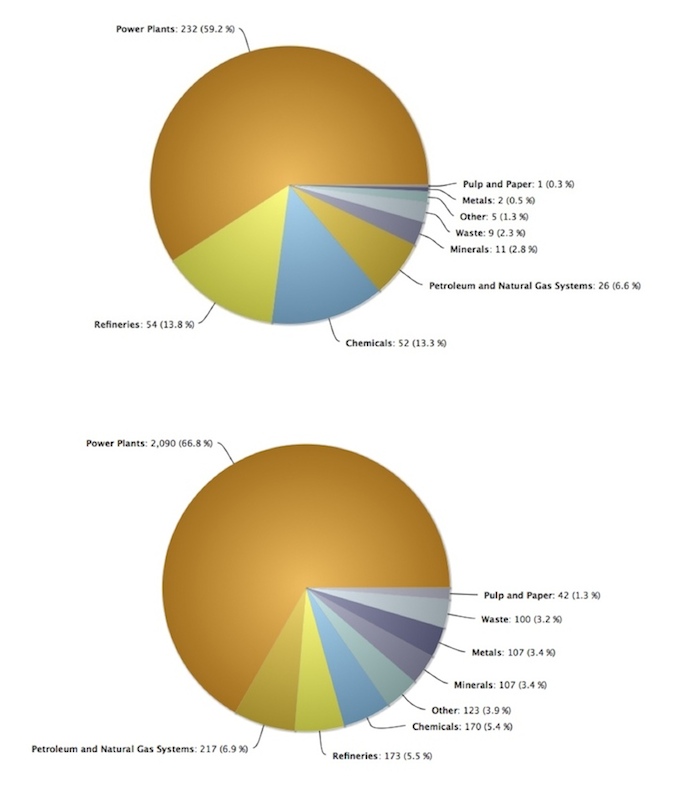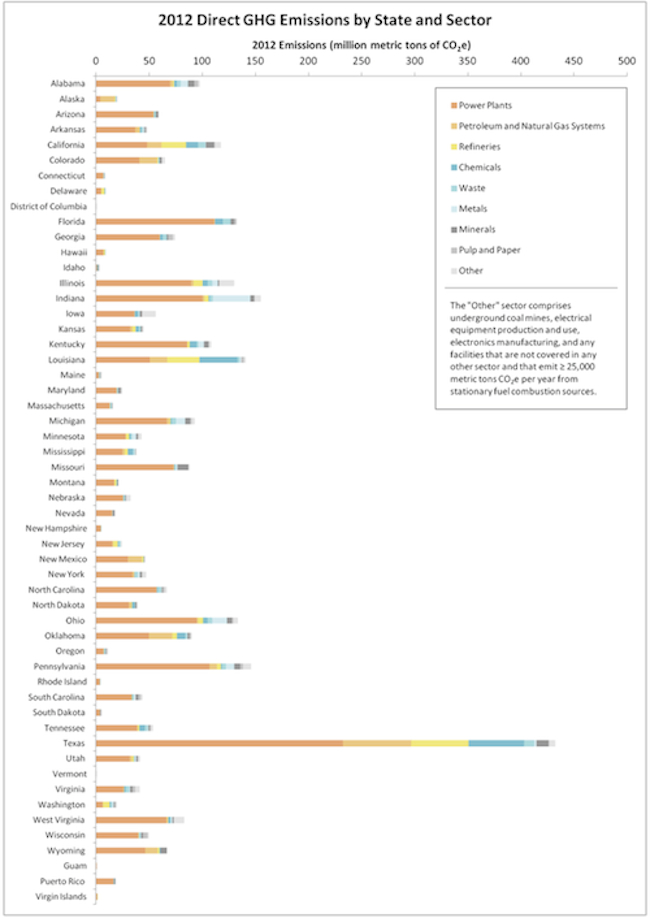Texas industrial facilities led all other states by a huge margin in their release of heat-trapping carbon dioxide, methane and other greenhouse gases in 2012, the U.S. Environmental Protection Agency announced this week.
The EPA report, based on data provided by about 8,000 facilities across the nation, showed that the ones in Texas said they emitted about 393 million metric tons of greenhouse gases last year – 12.5 percent of the nationwide total of 3.13 billion metric tons.
Climate Central, a non-profit news and science organization, reported that Texas’ total emissions of greenhouse gases (GHG) had far exceeded those in the other top-emitting states:
Texas alone was responsible for 393 million metric tons of greenhouse gas emissions, mostly from power plants, refineries and the chemical industry — more than three times the carbon footprint of California, which emitted only 114.6 million metric tons. Other states in the top five biggest GHG emitters were Indiana, with 154.6 million metric tons of GHG emissions, Pennsylvania with 142.7 million tons, Louisiana with 140.4 million metric tons and Ohio with 133.3 million metric tons.
The EPA noted that power plants, the major industrial source category for greenhouse gases, continue to report declining emissions:
The 2012 data show that in the two years since reporting began, emissions from power plants have decreased 10 percent. This is due to a switch from coal to natural gas for electricity generation and a slight decrease in electricity production. Fossil-fuel-fired power plants remain the largest source of U.S. greenhouse gas emissions. With just under 1,600 facilities emitting over 2 billion metric tons of carbon dioxide in 2012, these plants account for roughly 40 percent of total U.S. carbon pollution.
An analysis of the EPA data by Texas Climate News revealed that Texas power plants’ reported emissions reflected the national decline, dropping from 250 million metric tons in 2011 to 232 million metric tons last year. One factor in the reduction was likely lower power demand due to lower summer temperatures in 2012, compared to those recorded during Texas’ record-setting heat wave of 2011.
The main greenhouse gas emitted by power plants, carbon dioxide, fell from 249 million metric tons to 231 million metric tons in Texas from 2011 to 2012.
At the same time, however, the emissions of methane, a potent greenhouse gas that escapes to the atmosphere during oil and gas production activities and from decaying organic material in landfills, jumped in Texas.
Facilities in the EPA category “petroleum and natural gas systems” – oil and gas production and distribution – reported 3.3 million metric tons of methane emissions in 2012, up from 2.9 million metric tons in 2011.
Methane emissions from oil and gas operations have been increasingly controversial during their boom of recent years. Industry critics warn about the warming potential of these methane releases while industry representatives contend the GHG-reducing benefits of replacing coal with natural gas in power plants outweighs the climate-warming detriment of higher emissions from stepped-up production.
The biggest source category for methane emissions in Texas, the waste industry, reported its releases went up, too – from almost 9.3 million metric tons in 2011 to more than 9.4 million metric tons last year.
Refinery emissions of both methane and carbon dioxide rose from 2011 to 2012, as well. Texas refineries reported methane emissions up from 248,609 million metric tons to 295,499 million metric tons. Their CO2 emissions, meanwhile, went from 43 million metric tons to 54 million metric tons.

Power plants dominated both Texas' industrial facilities' emissions (top chart) and those from facilities across the nation in 2012.
The EPA reported these “data highlights” from the 2012 industry-provided data:
- The agency’s Greenhouse Gas Reporting Program, which doesn’t include emissions from transportation and other sources of heat-trapping pollution, represents about 85 to 90 percent of all U.S. emissions.
- All industrial facilities’ reported emissions fell by 4.5 percent from 2011 to 2012.
- Power plants represented about 40 percent of the nation’s carbon pollution and 67 percent of the emissions reported by industrial facilities last year.
- About 10 percent of the reporting facilities had emissions comprising 76 percent of the national industry total in 2012.
Image credit: U.S. Environmental Protection Agency

